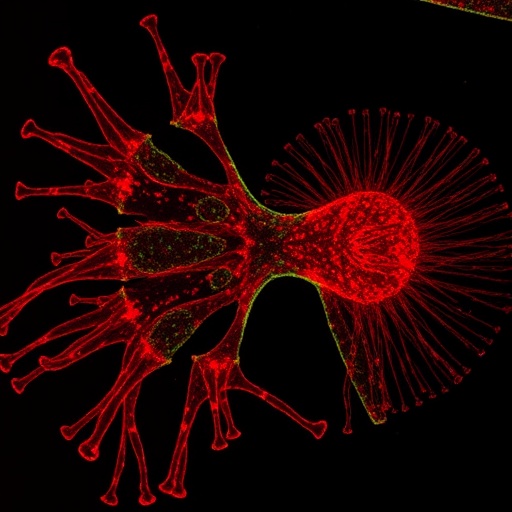In a groundbreaking study poised to reshape our understanding of hematopoietic disorders, researchers have unveiled how the protein SETBP1 acts as a pivotal regulator in chromatin architecture alterations linked to GATA2 deficiency. Utilizing human induced pluripotent stem cells (iPSCs) as a cutting-edge model system, this investigation delves deep into the molecular underpinnings of a rare yet clinically devastating condition characterized by defective blood cell development and immune dysregulation. The findings, published in Nature Communications, signal a crucial advance toward deciphering the epigenetic mechanisms that drive disease progression and open novel therapeutic avenues.
The GATA2 transcription factor plays an essential role in normal hematopoiesis and immune function. Mutations or haploinsufficiency in GATA2 precipitate a spectrum of clinical manifestations ranging from bone marrow failure to severe immunodeficiency syndromes and predisposition to myelodysplastic syndromes (MDS) and acute myeloid leukemia (AML). Despite its recognized importance, the complex molecular cascade initiated by GATA2 deficiency has remained enigmatic. Now, through precise genome editing and stem cell technologies, the research team led by Pera et al. sheds unprecedented light on the chromatin dynamics that accompany this deficiency.
Central to their discovery is SETBP1, a gene previously implicated in myeloid malignancies but whose role in the context of GATA2 deficiency has been unclear. SETBP1 encodes a protein known to bind DNA and modulate chromatin states, thereby influencing gene expression on a broad scale. By leveraging patient-derived iPSCs engineered to mimic GATA2 haploinsufficiency, the group demonstrated that aberrant upregulation of SETBP1 initiates widespread chromatin rewiring—a change in the three-dimensional organization of chromatin that profoundly impacts transcriptional programs fundamental to hematopoietic cell fate decisions.
The researchers employed state-of-the-art chromatin conformation capture techniques, combined with high-resolution sequencing, to map the spatial reorganization of chromatin domains in GATA2-deficient cells. The resulting data illustrated that SETBP1 drives the formation of novel chromatin loops and disrupts normal enhancer-promoter contacts, ultimately misregulating genes critical for stem cell maintenance and lineage commitment. Importantly, these chromatin alterations were not mere secondary effects but were shown through functional assays to actively contribute to the pathological phenotype.
Beyond characterizing the chromatin landscape, the study extensively dissected the transcriptional consequences of SETBP1-mediated rewiring. RNA sequencing revealed a distinctive gene expression signature marked by upregulation of oncogenic pathways and suppression of genes involved in DNA repair and cell cycle regulation. This dual effect likely predisposes hematopoietic stem cells to genomic instability and clonal evolution, providing a plausible mechanistic link between GATA2 deficiency and leukemogenesis.
Crucially, the team explored the therapeutic potential of targeting SETBP1-driven epigenetic dysregulation. Small-molecule inhibitors capable of modulating chromatin modifiers associated with SETBP1 were tested in iPSC-derived hematopoietic progenitors, showing partial restoration of normal chromatin topology and gene expression profiles. This proof-of-concept suggests that pharmacological intervention could mitigate the adverse clinical consequences of GATA2 mutations by correcting the underlying epigenetic aberrations.
The implications of these findings extend broadly. By demonstrating the interplay between transcription factor deficiency and chromatin architecture remodeling, this work underscores the intricate regulatory networks that preserve stem cell function and genomic integrity. It also exemplifies the power of iPSC-based disease modeling to recreate patient-specific molecular pathologies in vitro, offering a personalized platform for mechanistic studies and drug discovery.
Moreover, the elucidation of SETBP1’s role adds a new layer of complexity to the molecular landscape of myeloid diseases. SETBP1 mutations themselves have been identified in chronic myelomonocytic leukemia and other aggressive hematologic malignancies, but this research contextualizes its aberrant activity within a non-mutational framework driven by upstream transcription factor deficits. This insight prompts a reevaluation of SETBP1 as not only a genetic lesion but also a potential epigenetic node susceptible to modulation.
The methodological rigor and innovative approach applied in this study are notable. The generation of isogenic iPSC lines differing solely in GATA2 expression allowed for direct attribution of chromatin and transcriptional changes to this deficiency. Integration of chromatin topology mapping with transcriptomics and functional assays provides a comprehensive, multi-dimensional view of the disease process, setting a new standard for similar investigations in the field.
Furthermore, this research highlights the clinical relevance of epigenetic therapies in hematologic disorders traditionally viewed through a purely genetic lens. The reversibility of chromatin architecture defects observed upon chemical targeting hints at a dynamic landscape amenable to correction, offering hope to patients afflicted by conditions long lacking effective treatments.
Future investigations inspired by this work may focus on the interplay between SETBP1 and other epigenetic regulators, exploring combinatorial therapeutic strategies to fully restore normal hematopoiesis. Additionally, expanding investigations into how GATA2 deficiency impacts other cell types and tissues will deepen understanding of its pleiotropic clinical effects.
In essence, the study represents a milestone in comprehending how transcription factor abnormalities translate into structural genomic dysregulation with profound functional outcomes. The integration of human stem cell biology, genomics, and epigenetics embodied in this work exemplifies the frontier of regenerative medicine and disease modeling.
Ultimately, these insights pave the way for translational advances that could lead to patient-specific therapeutic regimes, incorporating targeted epigenetic modulators to combat hematopoietic failure and malignancy. The marriage of foundational molecular insights with practical clinical potential underscores the importance of continuing to unravel chromatin biology in complex diseases.
As the research community builds on these foundational discoveries, the vision of precision medicine tailored to the epigenetic and genomic signatures of each patient comes closer to reality. This study not only expands scientific knowledge but ignites new hope for patients suffering from the debilitating consequences of GATA2 deficiency-related disorders.
Subject of Research:
Article Title:
Article References:
Pera, J., Romero-Moya, D., Torralba-Sales, E. et al. Human iPSCs-based modeling unveils SETBP1 as a driver of chromatin rewiring in GATA2 deficiency. Nat Commun 16, 10035 (2025). https://doi.org/10.1038/s41467-025-65806-9
Image Credits: AI Generated
DOI: https://doi.org/10.1038/s41467-025-65806-9




